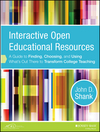Interactive Open Educational Resources: A Guide to Finding, Choosing, and Using What's Out There to Transform College TeachingISBN: 978-1-118-27745-4
192 pages
March 2014, Jossey-Bass

US $40.00
This price is valid for United States. Change location to view local pricing and availability. More Press Releases in: |
INTERACTIVE OPEN EDUCATIONAL RESOURCES: A Guide to Finding, Choosing, and Using What’s Out There to Transform College Teaching
Recent faculty surveys show that some of the most difficult challenges instructors face when teaching are motivating and engaging their students, while making connections to critical course content. And today’s students are “digital natives”—a generation who like to be able to watch, listen, read, and interact with their technology-rich environment. Consequently, interactive learning resources in various formats (including multimedia tutorials, modules, games, and simulations) are rapidly becoming vital learning resources for faculty and students to enhance both classroom and online learning. Unfortunately, it is difficult and confusing for faculty, librarians, and students to locate and utilize existing high-quality interactive learning resources.
Sponsored by the Association of College and Research Libraries (ACRL), a division of the American Library Association, INTERACTIVE OPEN EDUCATIONAL RESOURCES: A Guide to Finding, Choosing, and Using What’s Out There to Transform College Teaching (Jossey-Bass, a Wiley brand; January 2014; $38; Paper and available as an e-book; ISBN: 978-1-118-27745-4) is the only resource to weed through OERs to identify which ones are effective. It helps decipher the best tools, resources, and techniques for discovering, selecting, and integrating interactive learning resources into the higher education teaching and learning process.
Author John D. Shank examines many of the best repositories and digital library websites for finding high quality materials, explaining in depth the best practices for effectively searching these repositories and the various methods for evaluating, selecting, and integrating the resources into the instructor’s curriculum and course assignments, as well as the institution’s learning management system.
These new resources, and new activities centered around them, will increase student engagement with the course content, and enhance student learning. Additionally, instructors will learn how to employ and use interactive learning resources for student assessment.


